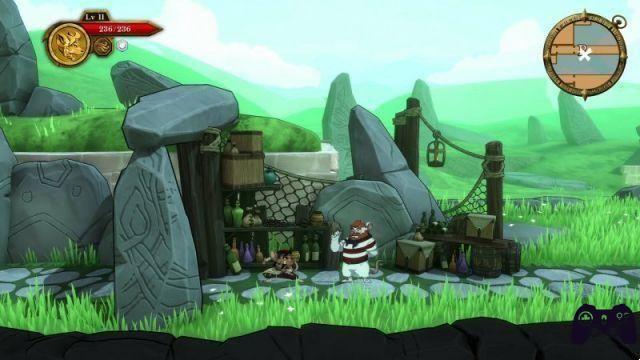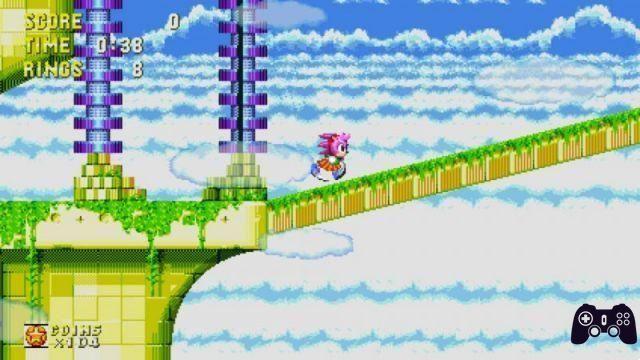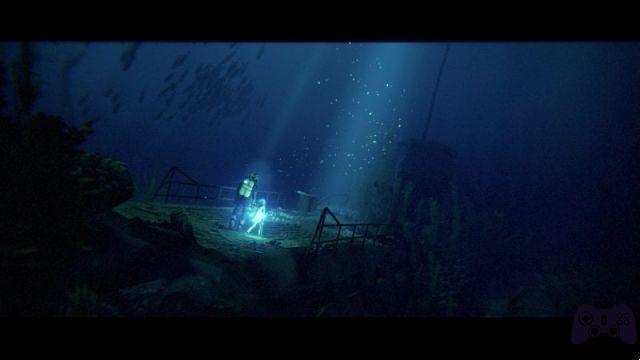Before Xenoblade Chronicles there was Baten Kaitos - it was the second title to be developed by Soft Monolith After Hirohide Sugiura, Tetsuya Takahashi and Yasuyuki Honne founded their own company in search of greater creative freedom. And Baten Kaitos, developed together with tri-Crescendo for GameCube, in a sense represented that much-needed creative freedom. The title did not sell as much as expected and barely justified a prequel, in which directors Honne and Hiroya Hatsushiba believed so much, but which achieved practically the same results - good critical and public success but sales below expectations - marked the premature end of a promising brand.
Twenty years have passed and we talk about it again at this historical moment in which the market draws heavily on the past to find a path to the future, perhaps inspiration now gone, perhaps an easy but limited profit. Ironically, the compilation we had in our hands has greater value for us on the European continent: it is the first time that Baten Kaitos Origins arrives in our area, having been confined to Japan and North America at the time of its first release. In our recensione di Baten Kaitos I & II HD Remaster We tell you, therefore, if it is worth recovering these two JRPGs from twenty years ago and if Bandai Namco has done a good job with a revival that absolutely deserves your attention.
Baten Kaitos... ¿uno y deboto?

The name of the compilation is actually misleading, because it is titled Baten Kaitos I & II when in reality the two games are called Baten Kaitos: Eternal Wings and the Lost Ocean and Baten Kaitos Origins. Not only that: what could be considered the second, in chronological order of release, is actually a prequel, but we advise you to play it afterwards anyway. Eternal wings and the lost ocean because the narrative, although autonomous, is structured in such a way that the inevitable references to the other game have a very particular impact if you already know the events told in the previous game.
Baten Kaitos Origins, in fact, takes place twenty years before Eternal Wings and Lost Ocean, and essentially tells how all the events were set in motion, explaining a significant part of these strange images. To those who come after reading the Monolith Soft imprint we will say this: Tetsuya Takahashi has almost nothing to do with these two titles, which were written by Masato Kato y Koh Kojima. The first signed stories of the caliber of Chrono Trigger, Chrono Cross and Final Fantasy XI, while the second directed the various Xenoblade Chronicles already released on Nintendo Switch.
In short, we are talking about top-level authors who have made history of the genre. And it shows by carrying forward the narrative of the two games, which manages to surprise in several aspects. At Baten Kaitos we assume the role of the guiding spirit of Party, a grumpy, profiteering protagonist with one natural wing and one mechanical one: In the world of Baten Kaitos, humans evolved to live on islands in the sky after the demon Malpercio dried up the ocean, making the surface uninhabitable. When Kalas and a mysterious makeshift traveling companion, Xelhá, accidentally unleash one of the seals imprisoning Malpercio, an adventure begins that will lead them to fight the despotic Emperor Geldoblame along with a series of unlikely allies.
The protagonist of Origins of Baten Kaitos, on the other hand, is called Sagi, but he can also communicate with the player, his guardian spirit. At the beginning of the story, Sagi and his companion Guillo - a kind of mechanical puppet animated by magic - are accused of a serious crime for which they will try to prove their innocence, ending up entangled in an ideological clash between followers of magic and those of science that will lay the foundations . from Eternal Wings and the Lost Ocean: throughout the story, in fact, several characters from the first game will appear, although twenty years younger.
On-demand gameplay

In the world of Baten Kaitos, humans have learned to channel the essence of certain objects into magical cards called Magnus: in addition to being trading goods and daily tools, these cards are the heart of the combat system that mixes turns and real time. The structure is typical of Japanese role-playing games, were it not for the world map in which you move from one setting to another following tracks in pure Chrono Trigger style: in the scenarios the wandering enemies are clearly visible and avoidable, if It is preferred; no random fights and interacting with the 3D model of the monster loads the combat into a separate screen.
In both games a maximum of three characters can be deployed: the basic dynamics are practically the same, but there are some differences between one chapter and another that significantly change the combat system. In the first Baten Kaitos, for example, the player is asked to compose a deck of cards for each character in the party, whereas in Origins you build a deck just for everyone. It may sound like card game terminology, and in a sense it is Baten Kaitos, so keep in mind your interest in this type of RPG: an apt comparison could be made with the more recent SteamWorld Quest and Slay the Spire.

As you progress you will be able to prepare and catalog different types of decks to change them if necessary, since a system of elemental vulnerabilities forces the player to carefully choose the cards to use: the game randomly draws a certain number from the deck during the player's attack turn, who must then select the appropriate cards, possibly calculating the value that marks them. By choosing cards of the same value or progressives, combos are formed that increase the total power of the attacks launched.
However, when it is the enemy's turn, the turn becomes defensive and the player has a few seconds to choose the cards that serve to mitigate the damage received: there are no real accessories such as armor or protections to use; everything is entrusted to Magnus' cards and the higher level that increases the main attributes of the characters. It is an ingenious system that contemplates a minimum of deck building strategy, especially in the second episode since the entire group draws with the same cards: it is one of the reasons that led Monolith Soft to significantly increase the difficulty of Origins compared to the original title. Unfortunately, the tutorials don't explain the nuances of the combat system well and it takes a few hours to master, especially in Origins, which is considerably more complex.

The combat system also relies on a number of additional features, such as chain attacks and EX combos, but this is the gist of it and manages to sustain itself throughout the duration of the games, which are completed in approximately 30-40 horas each one without counting various extras and secrets. Outside of combat, Baten Kaitos I & II HD Remaster manages to be engaging thanks to a series of strange gameplay dynamics that involve using Magnus cards to resolve side missions and environmental puzzles: in fact, the player can extract the essences of certain objects and trap them in cards for a second use, perhaps interacting with the scenery to open new passages and find hidden collectibles. Some Magnus cards change over time; The fruit can ripen and rot, changing the effect in battle and forcing the player to micromanage decks repeatedly.
For two JRPGs from the early 2000s, Baten Kaitos has aged well and retains that shine of originality that distinguished them at that time. These are certainly divisive titles, characterized by an exaggerated artistic direction that you may or may not like, but other aspects remain indisputable, such as the excellent soundtracks composed by motoi sakuraba, another historical name in the sector who wrote the music for series such as Tales, Star Ocean and Valkyrie Profile.
the remastered version

Bandai Namco did a good job overall with the remastering of the two games released on GameCube in 2003 and 2006, net of a few minor flaws. Both titles are dubbed entirely in Japanese, but if Baten Kaitos, for example, also has subtitles in Spanish, as well as in English, French, Spanish and German, Baten Kaitos Origins is subtitled in English only, and this could be a problem for those who do not know the Albion language.
From a technical point of view we cannot complain too much. The new resolution does not separate the redefined 3D models too much from the backgrounds as is the case in the vast majority of these conversions, and Remaster has preserved the superior quality of the meticulously detailed and beautifully animated environments. The game becomes 30 marks per second Mostly stable, but we noticed some small slowdowns at some points in the game, perhaps caused by less than perfect code optimization.

As for the additional features of this re-release, in addition to a very welcome system of automatic saving, it is possible to pause the game outside of combat to open a small menu in which it is possible to configure various useful parameters to customize the game. We can completely disable combat, for example, or establish a mode that allows us to defeat enemies with a single blow: stratagems designed for players who just want to enjoy the story without spending too much time with the game mechanics. You can also skip scenes or increase the movement speed up to 300% both in combat and during exploration.
Ultimately, we're talking about sensible features that Improve Life Quality and they help to smooth out those old-school RPG rough edges, such as the regeneration of enemies upon loading each screen which can become annoying when fights are practically impossible to avoid and tend to last too long. In short, we are far from lazy re-editions like the one of Tales of Symphonia from some time ago.
Conclusions
digital delivery Nintendo eShop Price 49,99 € Holygamerz.com 8.0 Readers (13) 7.9 your voteBaten Kaitos I & II HD Remaster is a highly recommended compilation for lovers of Japanese RPGs who fell in love with Monolith Soft from Xenoblade Chronicles onwards, but who missed their early works. Except for some unjustified absences - such as the Spanish subtitles in Baten Kaitos Origins - we have in our hands a sufficiently careful reissue of two very particular experiences, which deserve attention even just for the narrative, if not for the decidedly atypical combat systems. - Additional features make up for the rough edges of yesteryear, allowing more experienced players to customize the flow of play however they prefer.
PRO
- A beautiful remaster of two historic titles that risked being forgotten
- The stories are interesting and some twists are very memorable.
- The new features of the remaster are nice.
AGAINST
- The "card game" mechanics may not be to everyone's taste
- Some minor and limited fluency issues.
- Baten Kaito Origins does not have Spanish subtitles






